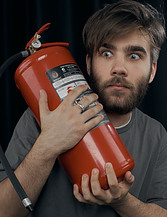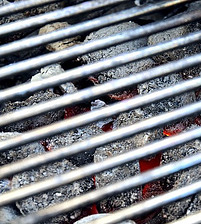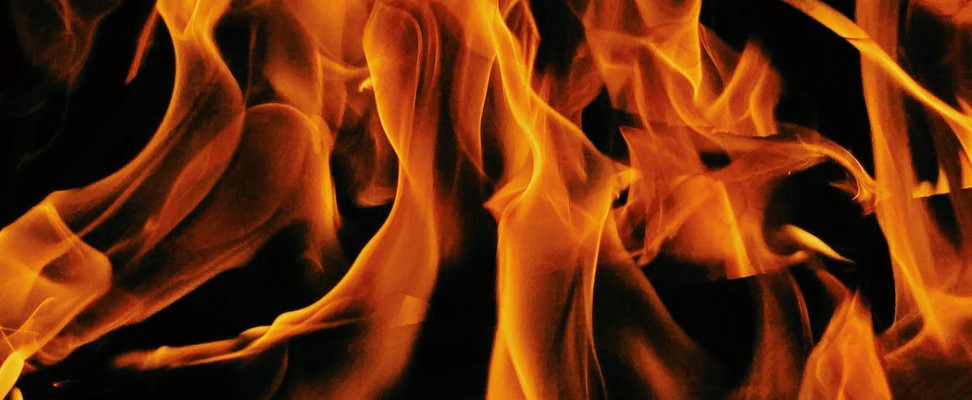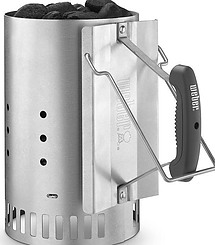Ok, we all know barbecue involves fire and that it’s hot. But are you aware of everything that can go wrong when we are using grills and smokers? Apparently, not everybody is up to speed. There are many statistics on home fires that started at a barbecue, and I won’t bother you with those numbers here. If you would like more information, you can have a look at the Home Grill Fires report published by the National Fire Protection Association.
From personal experience, I must admit that even after grilling and smoking food for decades, I still found a couple of things to add to my preparation and checklist when it comes to safety.
Safe Grilling Area

The first thing that comes to mind is that an outdoor grill area is solid and level. There must be stable footing for your grill, so it doesn’t easily fall over. Also, when you’re lighting a charcoal grill or if you have any flare ups while cooking, the flames can be surprisingly high. If you’re on a covered patio or balcony, there must be enough space above the grill, so the flare ups don’t set anything else on fire.
Keep the grilling area clean and tidy and get rid of any tripping hazards. Think ahead and have a place to put uncooked food and hot food coming of the grill. This way, you have your hands free to deal with any issues that may arise.
Finally, keep children and pets away from the grilling area to prevent accidents and burns. Depending on the situation and how many people are around, consider setting up a safety zone around the grill where only adults are allowed.
Barbecue Fire Safety
Always be prepared for the possibility of an unexpected barbecue grill fire either inside or outside the grill. Even if your grilling area is safe as can be and your grill is squeaky clean, things can still go wrong sometimes. Before you light the grill, have a plan for how to deal with a fire if necessary.

When there’s a fire inside the grill, closing the lid is an effective way to stop a fire, as this will starve the fire of oxygen. The lid of kettle type grills is not attached to the fire box, so make sure you have it handy when using the grill. Have a fire extinguisher within reach in case the fire spreads or starts outside the grill.
Since we’re cooking outside, we must be always aware of the weather. The main concern here is wind, especially when working with a charcoal or wood fire. Embers from the fire can be blown out of the grill and cause a fire, so it’s always best to put the grill in a spot where it’s shielded from the wind.
Just to make sure I’ve covered it, NEVER leave a lit grill or smoker unattended.
Barbecue Maintenance
You may have never thought about it this way, but the conditions for a runaway fire in a grill are often created by a lack of maintenance of the equipment.

One key item here is cleaning the grill, starting with the cooking grates. The best time to do this is right after you take the food off the grill and the grates are still hot. It’s much easier to remove stuck food particles at that time, rather than waiting until the grill cools down.
Whenever you cook, grease will drip down from the food onto the burners or the flavor bars that cover the burners. Pieces of food can also make their way down there. All of this is fuel for a grease fire and the build up needs to be removed on a regular basis. If your grill has a grease tray, clean or replace this at the same time, even if it’s not full.
For an ultimate guide to smoker and grill cleaning, check out my Barbecue Basics for Everyone page.
Over time, the gas connections on a gas grill can start leaking due to aging of the materials and exposure to the elements. Those leaks can start a fire and/or cause an explosion. At the start of grilling season and whenever you clean the burners, check the gas connections on a gas grill with soapy water.
The valves that control the gas flow to the burners don’t always shut of the gas complete when they’re turned to the off position. To prevent waste and gas buildup in the grill, always close the valve on the tank when you’re done cooking. This will also prevent loss of gas from any small leaks in the hoses from the tank to the burners.
It may seem like grills last forever, but there are parts that can wear out over time. I stayed at an Airbnb once with a grill on the patio. This grill must have been living outside most of its life, because the burners were so rusted that instead of many small holes there were just a few very big holes in the burner tubes. I don’t know what would happen if you lit a grill like that, since I didn’t try. The point is to keep an eye on the condition of your own equipment and always inspect a grill you’re not familiar with before you use it.
How to Light a Barbecue
For gas grills, always open the lid before you try to ignite the burners, so any gas can escape. If your grill doesn’t have an ignition function to light the burners, use a lighter with a long handle to light it.
For charcoal grills there are several options. There’s charcoal lighter fluid, but I don’t use it. It’s the most unsafe option and it can give a funky flavor to the food. Some briquettes have charcoal lighter fluid in them and are easy to light and safer, but flavor can still be a problem.
It’s easy to light charcoal without fluid. In my opinion, the best way to light a charcoal grill is with a chimney starter (As an Amazon Associate I earn from qualifying purchases). What is a charcoal chimney starter? The picture on the right shows what it looks like. To use it, put the desired amount of charcoal in the top portion of the chimney. Pour a bit of cooking oil on a wad of newspaper and/or paper towel, put this in the bottom portion of the chimney and set the whole contraption in the fire box. Then, light the paper and wait until the coals are red hot and flames come out of the top of the chimney.
Now you’re ready to turn the chimney over and pour the hot coal into the fire box. Always wear long, fire resistant gloves when you do this to prevent burns from any embers. Here too, check where the wind is coming from or you may be hit with some embers, especially when using wood charcoal instead of briquettes.
Finally, set the hot chimney in a safe place and let it cool down. I usually put it in my offset smoker or gas grill and close the lid to make sure nobody will touch it.
Conclusion
I hope this article was helpful and that you picked something up you can use. Barbecue is a great pastime, but accidents can have serious consequences. If there’s anything you think should be included here, please let me know, I always appreciate feedback!
Thank you for visiting and talk to you soon,
Herman


